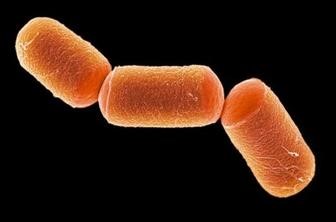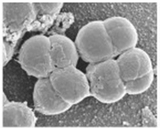ArchaeomeGut Methanogens
Archaea in mans

Archaea are regular components of human microbiota, and this is especially true for the gut microbiota. In this microbiome, there are more specifically anaerobic, methanogenic archaea, at least for what we currently know. They are found in quite all adults.
This presence has been known for a very long time by the fact that the methane produced in the intestine is notably exhaled: thus, finding methane in the exhaled breath indicates the presence of methanogens with counts greater than 107 ( 10,000,000) per gram of intestinal residue.
A high number in some people...... but with a overall low diversity

The methanogenic archaea are divided into 7 taxonomic orders. It has been known since the 1980s that two members of the Methanobacteriales Order are common residents of gastrointestinal microbiota. They are described in more detail below. They are:
- Methanobrevibacter smithii , present in at least 4 out of 5 people: however, its prevalence apparently depends on the population, the age of people, lifestyle / diet: for example, they would be less prevalent among urban dwellers than in rural areas, as a study on Chinese populations recently showed.
- Methanosphaera stadtmanae whose prevalence seems less important than assumed previously, probably in the range of one out three to five.
Do you find the name unpronounceable? We too ... so we will make frequent references to them by talking about "Mx". Recently discovered, general data of their prevalence are lacking, but it is thought that they remain infrequent in Western youth and adults, and are found in 1 out 4 elderly, or even 2 under certain conditions. They are also extremely present in an Amazonian tribe of Venezuela, the Yanomami (learn more about these people here), whatever old they are. They have very original features that you can found here.
Methanobrevibacter smithii

Methanobrevibacter smithii is depicted on the right from a picture obtained from wikipedia (https://en.wikipedia.org/wiki/Methanobrevibacter_smithii).
- it is an hydrogenotroph performing a "classical" methanogenesis from CO2 and H2
- it is very sensitive to oxygen.
- However, it can also use formate, without needing H2.
- Our work has shown, in any case for human intestinal strains, the presence of genes to achieve methanogenesis from methanol (used with H2).
CO2 + 4H2 CH4 + 2H2O
Thus, 5 volumes of gas are converted into 1 volume of gas (1 mol of methane) and 2 mol of water.
- The methane is eliminated both by flatulence and by the exhaled breath. Thus, we can detect methanogenic archaea (and therefore most often Methanobrevibacter smithii) by detecting methane in the exhaled air of a subject. It is estimated that the detection of this methane corresponds to the presence of at least 10+7 methanogens per gram of fecal content. However, recent studies indicate that there may be other sources of methane found in the exhaled air, produced by our own endogenous metabolism, and not of microbial origin (see the work of Polag et al, 2017 ).
- The quantities of M. smithii can be huge! without apparently creating any problem for mans. Thus, works have shown very high proportions of M. smithii sometimes corresponding to 1 on 8 to 15 procaryotes, in some individuals (Russian living in rural areas).
- However, it is possible that methane is a gas that exert an effect on intestinal transit time / intestinal motility. It has been shown that this archaea is more prevalent in people with constipation, but is it a cause or a consequence? There are indeed arguments for these two cases (Pimentel Works, USA for a cause, our work for a consequence). These 2 theses do not oppose, and it is possible that there is a training effect: a slow transit time would favor the presence of M. smithii which in back, by methane generated, would promote a slowdown of time transit.
- This archaea seems very well tolerated by the digestive tract, and does not involve dendritic cell activations / inflammatory response (in any case, not more than than a low level), according to the works of Corinna Bang and Ruth Schmitz (Kiel University, Germany ), unlike Methanosphaera stadtmanae.
Methanosphaera stadtmanae

Methanosphaera stadtmanae was also isolated shortly after Methanobrevibacter smithii by the same American scientific team (Miller and Wolin). For nearly 30 years, they will be the only two archaea of the human intestinal microbiota.
Methanosphaera stadtmanae, however, remains much less prevalent than M. smithii. It is also a Methanobacteriale, it is nonetheless very different:
- its shape is very different (see the picture)
- its methanogenesis is also very different: it has been an exception for a very long time because it uses methanol CH3OH as an electron acceptor for methanogenesis with H2 as a donor. It is also unable to use CO2 and H2, which does not prevent it from being hydrogenotrophic.
- it could be (conditional) rather deleterious for the human organism, as several recent studies tend to show. Indeed, M. stadtmanae seems rather pro-inflammatory, both in the human digestive tract (Works of Corinna Bang and Ruth Schmitz, Kiel University, Germany) and elsewhere (especially in the lungs, initial works of Blais Lecours, Montreal). Circulating antibodies against M. stadtmanae are also frequently found in patients with Chronic Inflammatory Bowel Disease (IBD). M. stadtmanae RNAs appear to be involved in this pro-inflammatory response (works by Ruth Schmitz, 2017-2018, Kiel, Germany).